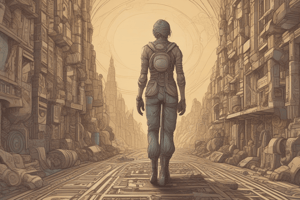Podcast
Questions and Answers
What is the primary source of information for most of our actions?
What is the primary source of information for most of our actions?
- Our intuition
- Trial and error
- Our own experiences
- Information from others (correct)
What is the main reason for our largest problems?
What is the main reason for our largest problems?
- Lack of resources
- Direct conflicts with others (correct)
- Poor decision-making
- Natural disasters
How do new individuals enter the environment and increase genetic variation?
How do new individuals enter the environment and increase genetic variation?
- Through random genetic mutations
- Through learning from others
- Through adaptations to their environment
- Through parental and random genetic combinations (correct)
What is the result of positively selected individuals in the environment?
What is the result of positively selected individuals in the environment?
What is the relationship between the tree of life and individual organisms?
What is the relationship between the tree of life and individual organisms?
What happens to the environment and gene pool as a result of evolution?
What happens to the environment and gene pool as a result of evolution?
What is the main advantage of the network approach in understanding evolution?
What is the main advantage of the network approach in understanding evolution?
What is the consequence of receiving help from others or eating food in the context of evolution?
What is the consequence of receiving help from others or eating food in the context of evolution?
What does adaptation mean in the context of evolution?
What does adaptation mean in the context of evolution?
What is the main flaw of the 'survival of the fittest' concept?
What is the main flaw of the 'survival of the fittest' concept?
What is the main difference between cultural evolution and genetic evolution?
What is the main difference between cultural evolution and genetic evolution?
What is a cultural element in the context of cultural evolution?
What is a cultural element in the context of cultural evolution?
What is the main pattern of cultural innovations?
What is the main pattern of cultural innovations?
Why is it not a problem that most culture and DNA of the past are unrecorded?
Why is it not a problem that most culture and DNA of the past are unrecorded?
Study Notes
The 3 Cs: Culture, Cooperation, Conflict, and Intertwined Concepts
- Culture refers to the information we learn from others
- Cooperation implies achieving things with direct help from others
- Conflict arises from direct conflicts with others, leading to problems
- These concepts are intertwined with other factors like state formation, inequality, climate change, etc.
Evolution
- Evolution is a combination of genetic variation, new individual entrance, competition, cooperation, and selection
- Genetic mutations are also a combination of genetic variations
- The process of evolution leads to adaptation, which means increasing the chances of survival and reproduction
The Tree of Life and Dynamic Networks
- The tree of life has entire species as elements, related by descent
- Zooming in yields a fine-grained image of individual organisms with their unique genes and interactions
- Evolution can be seen as a dynamic network, where each interaction (e.g., eating, mating, etc.) increases or decreases survival chances
What Evolution is Not
- Evolution is not "survival of the fittest," but rather survival of networks of complementary diversity
- Evolution does not serve a higher purpose and is not deterministic
- It does not yield optimal adaptation due to environmental changes, trade-offs, and ongoing maladaptations
Cultural Evolution
- Cultural evolution is the transmission of learned information, such as social norms, knowledge, and artifacts
- Cultural elements can be crisp (numbers) or fuzzy (styles)
- Examples of cultural elements include social norms, knowledge on how to make or handle technology, and more
- Cultural evolution can be seen as a tree, with gaps in the past, but general patterns and explanatory principles can still be understood
Studying That Suits You
Use AI to generate personalized quizzes and flashcards to suit your learning preferences.
Description
This quiz covers key concepts in sociology and anthropology, including culture, cooperation, conflict, and their intersections with state formation, inequality, and climate change.




